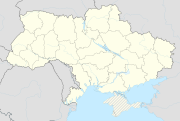Karachyniv
| Karaczynów | ||
| Карачинів | ||

|
|
|
| Basic data | ||
|---|---|---|
| Oblast : | Lviv Oblast | |
| Rajon : | Javoriv Raion | |
| Height : | 288 m | |
| Area : | 1.604 km² | |
| Residents : | 515 (2001) | |
| Population density : | 321 inhabitants per km² | |
| Postcodes : | 81086 | |
| Area code : | +380 3259 | |
| Geographic location : | 49 ° 52 ' N , 23 ° 50' E | |
| KOATUU : | 4625882902 | |
| Administrative structure : | 1 village | |
| Address: | 81086 с. Вороців | |
| Statistical information | ||
|
|
||
Karaczynów ( Ukrainian Карачинів ; Russian Карачинов Karatschinow , Polish Karaczynów , formerly Kroczonów ) is a village in the western Ukrainian Lviv Oblast with about 720 inhabitants.
It belongs to the villages Palanky ( Паланки ) Soluky ( Солуки ) and Woroziw ( Вороців ) for District Municipality Woroziw .
history
The place was mentioned in documents in 1492 as Croczonow and later as Kroczanow (1515), Karaczenow (1578), Karaczynow (1661–1665). The name is derived from the word possessive kрoчeн (Polish Kroczon from kroczyć - stride ).
It initially belonged to the Lviv region in the Ruthenian Voivodeship of the aristocratic republic of Poland-Lithuania . During the first partition of Poland in 1772 the village became part of the new Kingdom of Galicia and Lodomeria of the Habsburg Empire (from 1804).
In 1900 the Karaczynów community had 113 houses with 748 inhabitants, of which 443 were Ruthenian-speaking, 255 German-speaking, 50 Polish-speaking, 433 Greek-Catholic, 52 Roman-Catholic, 38 Jews and 225 of other faiths.
After the end of the Polish-Ukrainian War in 1919, the community became part of Poland. In 1921 it had 117 houses with 715 inhabitants, of which 636 Poles, 56 Ruthenians, 11 Germans, 12 Jews (nationality), 545 Greek Catholic, 47 Roman Catholic, 79 Protestant, 44 Jews (religion)
In the Second World War , the place belonged first to the Soviet Union and from 1941 to the General Government , from 1945 back to the Soviet Union, now part of the Ukraine .
Schonthal
In 1785 in the course of the Josephine colonization , German colonists of the Lutheran denomination were settled on the grounds of the village. The colony was called Schönthal and became an independent municipality. In 1786 the Protestants founded a branch parish of the parish of Lemberg in the Evangelical Superintendentur AB Galicia .
In 1900 the community of Schönthal had 32 houses with 217 inhabitants, 176 of them German-speaking, 34 Ruthenian-speaking, 7 Polish-speaking, 30 Greek-Catholic, 5 Roman-Catholic, 6 Jews, 176 of other faiths.
In 1921 the community of Schönthal had 32 houses with 209 inhabitants, all of them Poles, 110 Protestant, 70 Greek-Catholic, 20 Roman-Catholic, 9 Jews.
On March 11, 1939 the name Schönthal was changed to Uroczysko .
Web links
- Karaczynów . In: Filip Sulimierski, Władysław Walewski (eds.): Słownik geograficzny Królestwa Polskiego i innych krajów słowiańskich . tape 3 : Haag – Kępy . Sulimierskiego and Walewskiego, Warsaw 1882, p. 828 (Polish, edu.pl ).
- Impressions from the former Schönthal, Gródek district, Ukraine (PDF; 701 kB). Aid Committee of the Galiziendeutschen eV Publication from June 2012. Accessed on December 12, 2016.
Individual evidence
- ^ Anna Czapla: Nazwy miejscowości historycznej ziemi lwowskiej [The names of the villages in the historic Lviv region] . Towarzystwo Naukowe Katolickiego Uniwersytetu Lubelskiego Jana Pawła II, Lublin 2011, ISBN 978-83-7306-542-0 , p. 96 (Polish).
- ↑ Ludwig Patryn (Ed.): Community encyclopedia of the kingdoms and countries represented in the Reichsrat, edited on the basis of the results of the census of December 31, 1900, XII. Galicia . Vienna 1907.
- ↑ a b Główny Urząd Statystyczny: Skorowidz miejscowości Rzeczypospolitej Polskiej. Tom XIII. Województwo lwowskie . Warszawa 1924 (Polish, online [PDF]).
- ↑ Henryk Lepucki: Działalność kolonizacyjna Marii Teresy i Józefa II w Galicji 1772-1790: z 9 tablicami i MAPA . Kasa im. J. Mianowskiego, Lwów 1938, p. 163-165 (Polish, online ).
- ↑ Schematism of the Evangelical Church in Augsb. and Helvet. Confession in the kingdoms and countries represented in the Austrian Imperial Council . Vienna 1875, p. 215-217 ( online ).
- ↑ Ludwig Patryn (Ed.): Community encyclopedia of the kingdoms and countries represented in the Reichsrat, edited on the basis of the results of the census of December 31, 1900, XII. Galicia . Vienna 1907.
- ↑ MP 1939 No. 58 poz. 108. (Polish) (PDF file; 48.6 kB).

